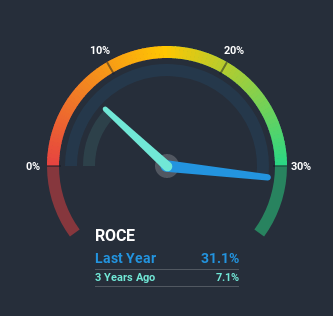- Brazil
- /
- Transportation
- /
- BOVESPA:JSLG3
We Like JSL's (BVMF:JSLG3) Returns And Here's How They're Trending

If you're not sure where to start when looking for the next multi-bagger, there are a few key trends you should keep an eye out for. One common approach is to try and find a company with returns on capital employed (ROCE) that are increasing, in conjunction with a growing amount of capital employed. If you see this, it typically means it's a company with a great business model and plenty of profitable reinvestment opportunities. Speaking of which, we noticed some great changes in JSL's (BVMF:JSLG3) returns on capital, so let's have a look.
What is Return On Capital Employed (ROCE)?
For those who don't know, ROCE is a measure of a company's yearly pre-tax profit (its return), relative to the capital employed in the business. Analysts use this formula to calculate it for JSL:
Return on Capital Employed = Earnings Before Interest and Tax (EBIT) ÷ (Total Assets - Current Liabilities)
0.31 = R$1.1b ÷ (R$4.2b - R$587m) (Based on the trailing twelve months to September 2020).
Therefore, JSL has an ROCE of 31%. In absolute terms that's a great return and it's even better than the Transportation industry average of 7.5%.
Check out our latest analysis for JSL

In the above chart we have measured JSL's prior ROCE against its prior performance, but the future is arguably more important. If you'd like, you can check out the forecasts from the analysts covering JSL here for free.
What The Trend Of ROCE Can Tell Us
You'd find it hard not to be impressed with the ROCE trend at JSL. The figures show that over the last five years, returns on capital have grown by 224%. That's a very favorable trend because this means that the company is earning more per dollar of capital that's being employed. In regards to capital employed, JSL appears to been achieving more with less, since the business is using 39% less capital to run its operation. If this trend continues, the business might be getting more efficient but it's shrinking in terms of total assets.
In another part of our analysis, we noticed that the company's ratio of current liabilities to total assets decreased to 14%, which broadly means the business is relying less on its suppliers or short-term creditors to fund its operations. Therefore we can rest assured that the growth in ROCE is a result of the business' fundamental improvements, rather than a cooking class featuring this company's books.What We Can Learn From JSL's ROCE
In the end, JSL has proven it's capital allocation skills are good with those higher returns from less amount of capital. And investors seem to expect more of this going forward, since the stock has rewarded shareholders with a 49% return over the last five years. Therefore, we think it would be worth your time to check if these trends are going to continue.
One more thing: We've identified 4 warning signs with JSL (at least 2 which are a bit unpleasant) , and understanding these would certainly be useful.
If you want to search for more stocks that have been earning high returns, check out this free list of stocks with solid balance sheets that are also earning high returns on equity.
If you decide to trade JSL, use the lowest-cost* platform that is rated #1 Overall by Barron’s, Interactive Brokers. Trade stocks, options, futures, forex, bonds and funds on 135 markets, all from a single integrated account. Promoted
New: Manage All Your Stock Portfolios in One Place
We've created the ultimate portfolio companion for stock investors, and it's free.
• Connect an unlimited number of Portfolios and see your total in one currency
• Be alerted to new Warning Signs or Risks via email or mobile
• Track the Fair Value of your stocks
This article by Simply Wall St is general in nature. It does not constitute a recommendation to buy or sell any stock, and does not take account of your objectives, or your financial situation. We aim to bring you long-term focused analysis driven by fundamental data. Note that our analysis may not factor in the latest price-sensitive company announcements or qualitative material. Simply Wall St has no position in any stocks mentioned.
*Interactive Brokers Rated Lowest Cost Broker by StockBrokers.com Annual Online Review 2020
Have feedback on this article? Concerned about the content? Get in touch with us directly. Alternatively, email editorial-team (at) simplywallst.com.
About BOVESPA:JSLG3
Undervalued with high growth potential.
Market Insights
Community Narratives



